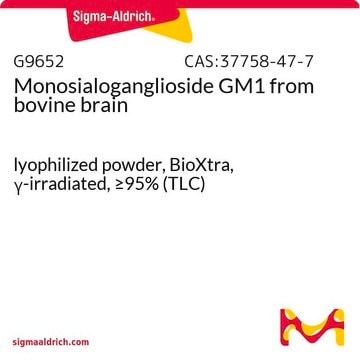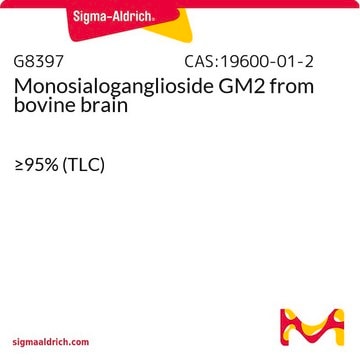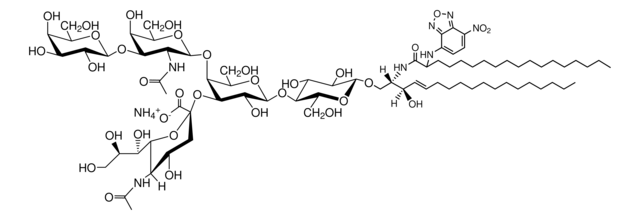G3018
Asialogangliosid GM1 aus Rinderhirn
~98%, lyophilized powder
Synonym(e):
Gangliosid GM1, asialo, Gangliotetraosyl-ceramid
About This Item
Empfohlene Produkte
Assay
~98%
Qualitätsniveau
Form
lyophilized powder
Lagertemp.
−20°C
InChI
1S/C62H114N2O23/c1-4-6-8-10-12-14-16-18-19-21-23-25-27-29-31-33-46(71)64-40(41(70)32-30-28-26-24-22-20-17-15-13-11-9-7-5-2)38-80-60-54(78)51(75)57(44(36-67)83-60)86-62-55(79)52(76)56(45(37-68)84-62)85-59-47(63-39(3)69)58(49(73)43(35-66)81-59)87-61-53(77)50(74)48(72)42(34-65)82-61/h30,32,40-45,47-62,65-68,70,72-79H,4-29,31,33-38H2,1-3H3,(H,63,69)(H,64,71)/b32-30+/t40?,41?,42-,43-,44-,45-,47-,48+,49+,50+,51-,52-,53-,54-,55-,56+,57-,58-,59+,60?,61+,62+/m1/s1
InChIKey
VELGMVLNORPMAO-JTFNWEOFSA-N
Suchen Sie nach ähnlichen Produkten? Aufrufen Leitfaden zum Produktvergleich
Verwandte Kategorien
Amino Acid Sequence
Allgemeine Beschreibung
Biochem./physiol. Wirkung
Lagerklassenschlüssel
11 - Combustible Solids
WGK
WGK 3
Flammpunkt (°F)
Not applicable
Flammpunkt (°C)
Not applicable
Persönliche Schutzausrüstung
Eyeshields, Gloves, type N95 (US)
Analysenzertifikate (COA)
Suchen Sie nach Analysenzertifikate (COA), indem Sie die Lot-/Chargennummer des Produkts eingeben. Lot- und Chargennummern sind auf dem Produktetikett hinter den Wörtern ‘Lot’ oder ‘Batch’ (Lot oder Charge) zu finden.
Besitzen Sie dieses Produkt bereits?
In der Dokumentenbibliothek finden Sie die Dokumentation zu den Produkten, die Sie kürzlich erworben haben.
Kunden haben sich ebenfalls angesehen
Artikel
Understand sialic acid structure, function, signaling, and modifications. Easily find products for sialic acid research.
Discover Bioactive Small Molecules for Lipid Signaling Research
Unser Team von Wissenschaftlern verfügt über Erfahrung in allen Forschungsbereichen einschließlich Life Science, Materialwissenschaften, chemischer Synthese, Chromatographie, Analytik und vielen mehr..
Setzen Sie sich mit dem technischen Dienst in Verbindung.












